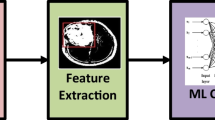Abstract
Early detection of cancer can increase patients’ survivability and treatment options. Medical images such as Mammogram, Ultrasound, Magnetic Resonance Imaging, and microscopic images are the common method for cancer diagnosis. Recently, computer-aided diagnosis (CAD) systems have been used to help physicians in cancer diagnosis so that the diagnosis accuracy can be improved. CAD can help in decreasing missed cancer lesions due to physician fatigue, reducing the burden of workload and data overloading, and decreasing variability of inter- and intra-readers of images. In this research, a framework of CAD systems for cancer diagnosis based on medical images has been proposed. The proposed work helps physicians in detection of suspicion regions using different medical images modalities and in classifying the detected suspicious regions as normal or abnormal with the highest possible accuracy. The proposed framework of CAD system consists of four stages which are: preprocessing, segmentation of regions of interest, feature extraction and selection, and finally classification. In this research, the framework has been applied on blood smear images to diagnose the cases as normal or abnormal for Acute Lymphoblastic Leukemia (ALL) cases. Ant Colony Optimization (ACO) has been used to select the subsets of features from the features extracted from segmented cell parts which can maximize the classification performance as possible. Different classifiers which are Decision Tree (DT), K-nearest neighbor (K-NN), Naïve Bayes (NB), and Support Vector Machine (SVM) have been applied. The framework has been yielding promising results which reached 96.25% accuracy, 97.3% sensitivity, and 95.35% specificity using decision tree classifier.









Similar content being viewed by others
References
World Health Organization (WHO), http://www.who.int/mediacentre/factsheets/fs297/en/, last visited January 2018.
Gatuha, G. and Jiang, T., Evaluating diagnostic performance of machine learning algorithms on breast cancer. In International Conference on Intelligent Science and Big Data Engineering. Springer, 2015.
Witten, I. H., et al., Data Mining: Practical machine learning tools and techniques. Morgan Kaufmann, 2016.
Mohanty, A. K., Senapati, M. R., and Lenka, S. K., RETRACTED ARTICLE: An improved data mining technique for classification and detection of breast cancer from mammograms. Neural Computing and Applications 22(1):303–310, 2013.
Xie, W., Li, Y., and Ma, Y., Breast mass classification in digital mammography based on extreme learning machine. Neurocomputing 173:930–941, 2016.
Mohapatra, S., Patra, D., and Satpathi, S., Image analysis of blood microscopic images for acute leukemia detection. In Industrial Electronics, Control & Robotics (IECR), 2010 International Conference on. IEEE, 2010.
Kooi, T., Litjens, G., van Ginneken, B., Gubern-Mérida, A., Sánchez, C. I., Mann, R., den Heeten, A., and Karssemeijer, N., Large scale deep learning for computer aided detection of mammographic lesions. Medical image analysis 35:303–312, 2017.
Vishnuvarthanan, A., Rajasekaran, M. P., Govindaraj, V., Zhang, Y., and Thiyagarajan, A., An automated hybrid approach using clustering and nature inspired optimization technique for improved tumor and tissue segmentation in magnetic resonance brain images. Applied Soft Computing 57:399–426, 2017.
Veeramuthu, A., Meenakshi, S., and Darsini, V. P., Brain image classification using learning machine approach and brain structure analysis. Procedia Computer Science 50:388–394, 2015.
Escalante, H. J., Montes-y-Gómez, M., González, J. A., Gómez-Gil, P., Altamirano, L., Reyes, C. A., Reta, C., and Rosales, A., Acute leukemia classification by ensemble particle swarm model selection. Artificial intelligence in medicine 55(3):163–175, 2012.
Rawat, J., Singh, A., Bhadauria, H. S., and Virmani, J., Computer aided diagnostic system for detection of leukemia using microscopic images. Procedia Computer Science 70:748–756, 2015.
Putzu, L., Caocci, G., and Di Ruberto, C., Leucocyte classification for leukaemia detection using image processing techniques. Artificial intelligence in medicine 62(3):179–191, 2014.
Labati, R. D., Piuri, V., and Scotti, F., All-IDB: The acute lymphoblastic leukemia image database for image processing. in Image processing (ICIP), 2011 18th IEEE international conference on. September 11–14, Brussels, Belgium: IEEE, 2011.
Han, J., Kamber, M., and Pei, J., Data mining: Concept and techniques. San Francisco: Morgan Kaufman Publisher, 2006.
Kremer, H. A. W., Eric, W.,. "Isoperimetric Quotient." From MathWorld--A Wolfram Web Resource. Available from: http://mathworld.wolfram.com/IsoperimetricQuotient.html.
El Houby, E. M., Yassin, N. I., and Omran, S., A hybrid approach from ant Colony optimization and K-nearest neighbor for classifying datasets using selected features. Informatica, 41(4), 2017.
Han, J., Pei, J., and Kamber, M., Data mining: concepts and techniques. Elsevier, 2011.
Acknowledgments
This work was funded by National Research Centre (NRC), Cairo, Egypt. Authors are grateful to NRC for funding the project (grant number 11090333).
Author information
Authors and Affiliations
Corresponding author
Ethics declarations
Conflict of interest
The authors have no conflict of interests to declare.
Ethical approval
This article does not contain any studies with human participants or animals performed by any of the authors.
Additional information
This article is part of the Topical Collection on Image & Signal Processing
Rights and permissions
About this article
Cite this article
El Houby, E.M.F. Framework of Computer Aided Diagnosis Systems for Cancer Classification Based on Medical Images. J Med Syst 42, 157 (2018). https://doi.org/10.1007/s10916-018-1010-x
Received:
Accepted:
Published:
DOI: https://doi.org/10.1007/s10916-018-1010-x




